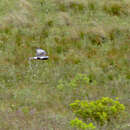Biology
(
Inglês
)
fornecido por Arkive
This aerial hunter feeds primarily on rodents, small birds and the occasional reptile (7), but also eats eggs, insects and, very occasionally, carrion (2). The black harrier soars low over the vegetation searching for prey, often hovering before plunging down to seize its meal (2).
Like other harriers, the black harrier makes an undulating courtship flight which precedes mating (2). Black harriers breed mainly in the wet season, and have been recorded laying eggs from July to September. Three to four pairs may nest close to one another (2), each building an untidy nest of grass at the base of stems, reeds or weeds (2). The three to four eggs that are laid are incubated for around 34 days, and the chicks fledge after 36 to 41 days (2). In winter, black harriers migrate north to the dry steppe and grassland habitats of southern Namibia, southern Botswana and southern Transvaal (2).
Conservation
(
Inglês
)
fornecido por Arkive
The black harrier is listed in Appendix II of the Convention on International Trade in Endangered Species (CITES), meaning that any trade in this bird should be carefully regulated (3). It is also listed on Appendix II of the Convention on Migratory Species, which encourages range states to conclude agreements that will benefit the conservation of the migratory black harrier (4). The black harrier also occurs in a number of protected areas, such as Fernkloof Nature Reserve, which offers a degree of protection. In 2000, a research project on the biology and conservation status of the black harrier in the Western Cape was initiated by the Percy Fitzpatrick Institute of African Ornithology (7), which has improved knowledge of this rare bird, but further conservation actions, such as additional monitoring and research, and the provision of incentives to landowners to manage valuable grassland habitat (5), are required to ensure the survival of this impressive bird of prey.
Description
(
Inglês
)
fornecido por Arkive
This striking bird of prey breeds in the unique and incredibly diverse fynbos habitat of South Africa; a habitat which is threatened by the activities of humans. Adult black harriers have black plumage with bold white stripes across the tail, a white rump, and conspicuous white wing panels (2) (5). Females are larger than males, and juveniles can be distinguished by their dark brown plumage, which is heavily mottled and streaked (2) (5). The genus name of the black harrier, Circus, refers to the male's circling, acrobatic flight display, undertaken to impress a female during courtship (6).
Habitat
(
Inglês
)
fornecido por Arkive
The black harrier breeds in the fynbos habitat of the Cape Floral Kingdom and adjacent karooid scrub and grasslands. Outside breeding season it moves north to drier grassland, scrub and steppe (2).
Range
(
Inglês
)
fornecido por Arkive
Occurs in southern Africa, where it is primarily found in the Western Cape, Eastern Cape and Free State in South Africa, southern Botswana and Lesotho. A tiny, isolated population also exists in southern Namibia (1) (2).
Status
(
Inglês
)
fornecido por Arkive
Classified as Vulnerable (VU) by the IUCN Red List 2007 (1), and listed on Appendix II of CITES (3) and Appendix II of CMS (4).
Threats
(
Inglês
)
fornecido por Arkive
Whilst the black harrier is locally common, it is vulnerable to habitat degradation due to its restricted fynbos breeding habitat (2). Fynbos vegetation has been lost to agriculture, invasive alien vegetation and urbanization, resulting in the black harrier losing over 50 percent of its core breeding habitat over the last century (8). The diverse natural vegetation has been replaced by a sea of cereal (7), and evidence suggests that whilst black harriers forage in cropland, they generally do not breed in these modified habitats (8). In addition, black harriers are vulnerable to the impacts of pesticide and rodenticide use (2), which could accumulate within the bird, or reduce the availability of prey.

